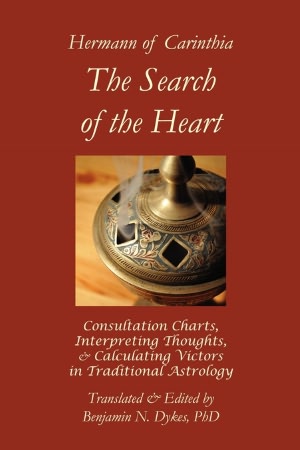
The Search for the Heart is a fascinating manuscript by Hermann of Carinthia. He lived in southern France from 1138 to 1143 CE, sometimes with his boon companion and fellow translator, Robert of Kelton. Hermann translated from Arabic into Latin, and one of his great interests was astrology. This book was written after 1140 and finished sometime around 1143. Benjamin Dykes proceeds with his demanding schedule of translations of ancient and rare astrological texts. The bulk of his books compile two or more small works into a single text. This text is now available for the first time as a translation for the modern reader.
Dykes inspected multiple manuscripts and Arabic sources to complete this translation. Copious annotations clarify the hinky bits for modern readers. Divisions in the book have been re-established so there are clear topical sections: thought interpretation chart techniques, horary questions, planetary configurations and timing, calculating a chart victor and releaser, and delineation tips.
This is clearly a cross-over text. While ancient Hellenic methods are preserved, Hermann’s instructions wander toward medieval methods as he compiles techniques from an assembly of Arabic-speaking authorities. Calculated house systems are mentioned (none specifically) but so are whole-sign houses. The shift to calculated house cusps hasn’t quite solidified yet. As Dykes acknowledges in the text, Hermann foreshadows the much-later work of Morin and Lilly.
This book is even more interesting since Hermann was well-read and had terrific access to lots of astrology books. He borrows material from Umar al Tabari and Al-Kindi, and makes references to Abu Ali al’ Khayyat, al Razi, Balinus (aka Apollonius), Hermes, Jirjis, Masha’Allah, and Sahl ibn Bishr. He gives clear attributions to the different methods used by these astrologers, and compares their various ideas about deriving information from charts.
In terms of content, the material on thought interpretation is absolutely singular and won’t be found elsewhere. A thought interpretation chart allows the astrologer to figure out what issue or situation caused the client to seek advice. The astrologer can get a jump on the session and quite possibly wow the client with great and unspeakable mystic powers—always good for business. What’s super-slick is that these charts really work! A similar wow factor is offered in the techniques for figuring out what the client is holding in his hand. Several tables with descriptions of color, size, texture, and material of each planet and sign are included, but since the lists are almost 1,000 years old, contemporary astrologers will have to do some creative adapting to make use of them. There’s also a section from Jirjis on finding hidden treasures, with additional advice culled from Umar and Al-Kindi.
The main topic of the third section is finding significators for charts. The chart victor is the planet with the most dignity points, and it describes the overall outcome of the chart. Hermann outlines a point system for determining the victor. Methods for finding the chart’s releaser and kadukhadah are given; these are planets that show the beginning of the matter, and are the victor’s assistants in chart judgment. Timing methods are examined, and a list of house topics is provided.
There’s a wicked little joke hidden in the text, too. Hermann’s analysis of the sample horary chart on page 142 is hampered by incorrect planetary positions. Dykes supplies a recalculated chart with correct planetary positions, there are still problems with judging the chart. Both charts give Saturn as the victor. Here’s the joke: Saturn is placed in the 7th house where Lilly (and perhaps Bonatti) says that it makes the chart unfit to be judged since the astrologer will be confounded. This chart was indeed confounding, and it was fun to find a 1,000 year-old brain teaser nobody’s ever spotted!
There are numerous appendices (A through M) that offer additional commentary from multiple Arabic authors on the subjects covered in Hermann’s book. This is an excellent forum for comparing how different astrologers worked with thought interpretation and horary charts. Appendix H gives Hellenistic Antecedents, and includes material from Ptolemy, Porphyry and Hephaistio, and a table of 12th parts. Appendix M describes Dykes’ “Essential Medieval Astrology Cycle” of finished and planned translations intended to encompass the whole spectrum of early astrological techniques. The end matter includes a bibliography and index.
This book is recommended for students of traditional astrology who’ve done a bit of preparatory reading and want to broach new and unusual topics with a phenomenal range of methods with comments from lots of different writers. The best thing is that these techniques really work and are easy to co-opt into contemporary astrological practice. Hermann’s book is singular in both topic and approach, and Dykes makes it digestible for the modern reader. Well done!
~review by Elizabeth Hazel
Translated and edited by Benjamin Dykes, Ph.D.
Cazimi Press, 2011
pp. 228, $24.95
www.bendykes.com, and www.astroamerica.com
